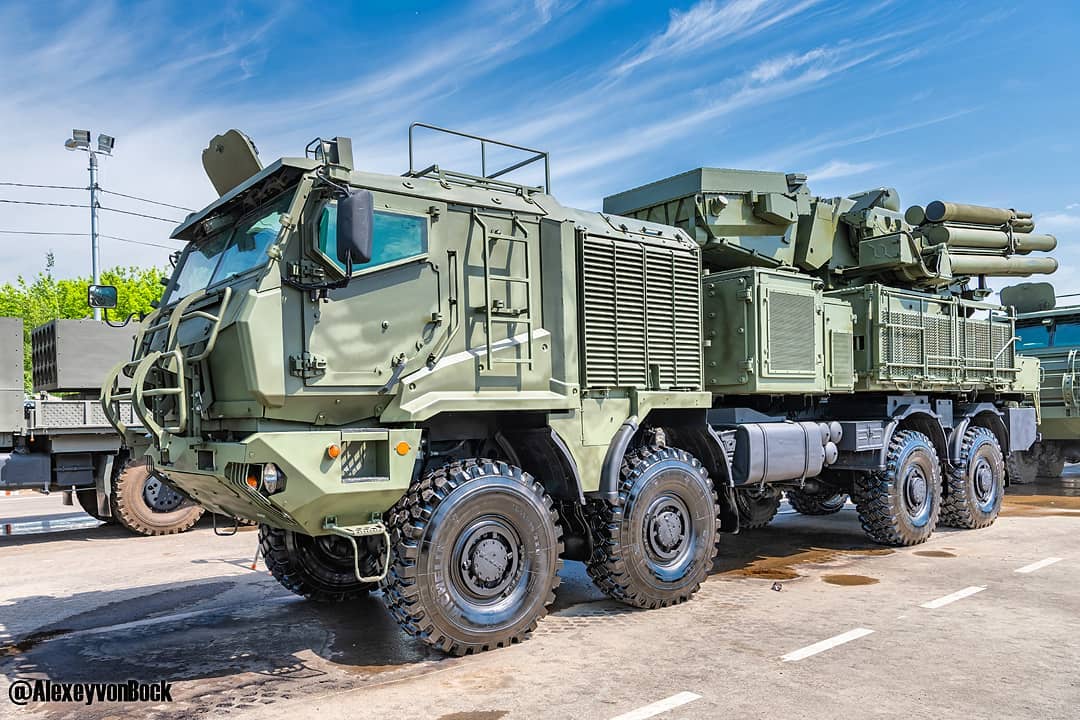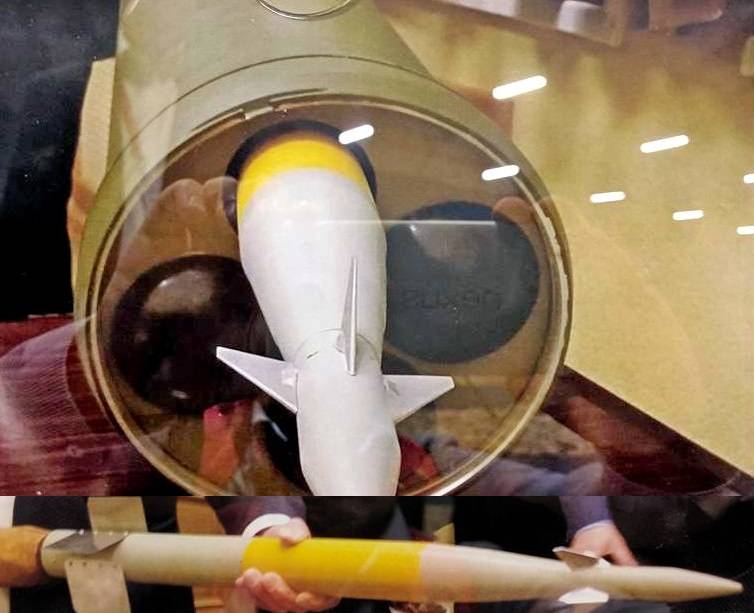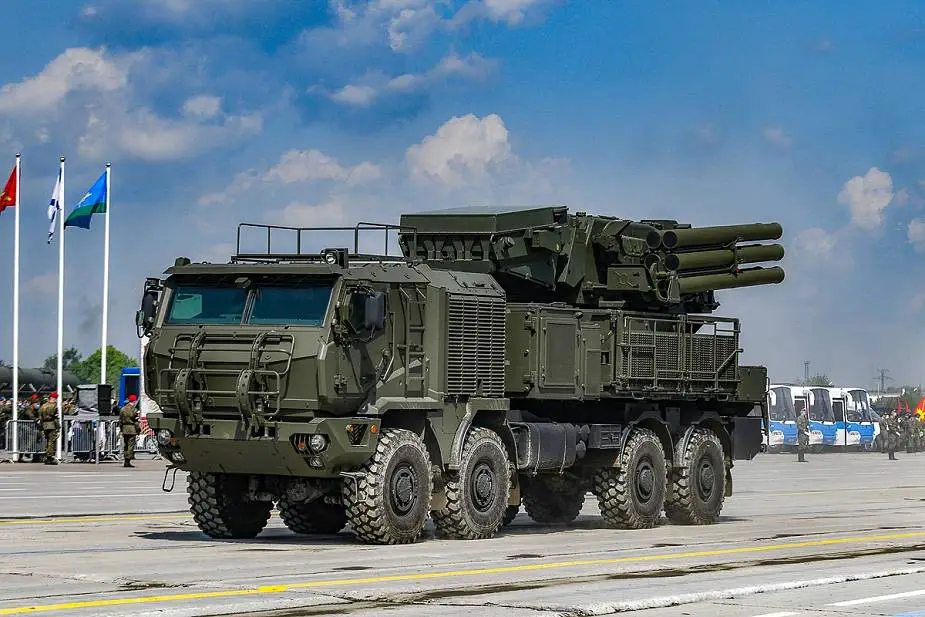Pancir-SzM, Ki vesz észre rajta valami érdekeset? 



Az elmúlt időszak tapasztalatai alapján házirendet kapott a topic.
Ezen témában - a fórumon rendhagyó módon - az oldal üzemeltetője saját álláspontja, meggyőződése alapján nem enged bizonyos véleményeket, mivel meglátása szerint az káros a járványhelyzet enyhítését célzó törekvésekre.
Kérünk, hogy a vírus veszélyességét kétségbe vonó, oltásellenes véleményed más platformon fejtsd ki. Nálunk ennek nincs helye. Az ilyen hozzászólásokért 1 alkalommal figyelmeztetés jár, majd folytatása esetén a témáról letiltás. Arra is kérünk, hogy a fórum más témáiba ne vigyétek át, mert azért viszont már a fórum egészéről letiltás járhat hosszabb-rövidebb időre.
Az elmúlt időszak tapasztalatai alapján frissített házirendet kapott a topic.
--- VÁLTOZÁS A MODERÁLÁSBAN ---
A források, hírek preferáltak. Azoknak, akik veszik a fáradságot és összegyűjtik ezeket a főként harcokkal, a háború jelenlegi állásával és haditechnika szempontjából érdekes híreket, (mindegy milyen oldali) forrásokkal alátámasztják és bonuszként legalább a címet egy google fordítóba berakják, azoknak ismételten köszönjük az áldozatos munkáját és további kitartást kívánunk nekik!
Ami nem a topik témájába vág vagy akár csak erősebb hangnemben is kerül megfogalmazásra, az valamilyen formában szankcionálva lesz
Minden olyan hozzászólásért ami nem hír, vagy szorosan a konfliktushoz kapcsolódó vélemény / elemzés azért instant 3 nap topic letiltás jár. Aki pedig ezzel trükközne és folytatná másik topicban annak 2 hónap fórum ban a jussa.


A felső tubusban 4 kisebb rakéta van? Összesen elvileg 16, plusz a 8 nagyobb.Pancir-SzM, Ki vesz észre rajta valami érdekeset?

A felső tubusban 4 kisebb rakéta van? Összesen elvileg 16, plusz a 8 nagyobb.

Követi a Tor-M1 --> M2 evolúcióját...Igen, a kis méretü drónok és nem irányított rakéták ellen.


Csocsesz ismét nagyot ment ! LOL
https://privatbankar.hu/cikkek/makr...elmet.html?utm_source=rss&utm_medium=referral
Nem is tudtam, hogy Putyinnak is van légvédelme és Putyin légvédelme van Líbiában és Szíriában.
Totál idióta ez a firkász.







Szerecsenmosdatás.Nem volt kedvem fordítgatni de mivel angolul van a fordító vígan megeszi.
Russian Pantsir Air Defense System- Sitting duck or Top Dog?

Ruslan Pukhov, director of the Centre for Analysis of Strategies and Technologies
Russian Pantsir air defense system (ADS) has been much maligned in the war zones of Syria and Libya as having been shot down by Turkish drones and Israeli jets. However, its manufacturers tout its impressive performance in protecting a Russian airbase in Syria against repeated drone attacks.
Nearly ten Pantsirs operated by the Libyan National Army (LNA) led by renegade commander Khalifa Haftar have been reportedly destroyed during May-June 2020. One Syrian Pantsir ADS was reportedly destroyed by an Israeli jet this January after its operator left behind a mobile phone which enabled the system to be tracked. In May 2018, another Pantsir ADS deployed in Syria is said to have taken a “direct hit” from a missile launched by Israeli fighter jets.
On the other hand, KBP Instrument Design Bureau that manufactures the Pantsir ADS, claimed it destroyed some 100 drones around the world in the past few years. Referring to a specific incident, Pantsir-S combined with electronic warfare system brought down 13 UAVs when a drone swarm attacked the Hymeimim air base in Syria during January 2018.
Defenseworld.net discussed the Pantsir system – its history, potential, market outlook, combat experience and future - with Ruslan Pukhov, director of the Centre for Analysis of Strategies and Technologies, the foremost independent Russian authority in the military and strategic issues.

Pantsir air defense system (image: Russian MoD)
1. Please tell us about the development of the Pantsir air defense system.
Self-propelled anti-aircraft gun-missile (SPAAGM) system Pantsir was created in accordance with technical requirements of the Russian Air Defense Forces, issued in the late 1980s, as a means of self-defense of S-300P long-range anti-aircraft missile systems. The Pantsir was supposed to provide cover for the near air defense zone of S-300P which means to track and defeat low-flying targets such as drones and helicopters that came to attack the S-300P. The system was developed by the Tula-based KBP Instrument Design Bureau, with Arkady Shipunov in-charge of engineering the system.
A. Shipunov used in the new system a high-speed two-stage bicaliber missile, which already had a significantly extended range. The prototype of the Pantsir was built quickly enough, and in 1995 it was demonstrated at MAKS airshow. But the military lost interest in it, and the funding also ceased. A few years later, the Pantsir project regained traction.
2. How did that happen? Did it have to do anything with United Arab Emirates buying the Pantsir?
The reincarnation of the Pantsir happened due to the efforts of the KBP, which culminated in the conclusion in 2000 of a contract with the first customer, the UAE. Persuasion by A. Shipunov made it possible to agree on the delivery of the air defense system, which at that time was even not in service with the Russian army.
The design of the system, which became known as the Pantsir-S1, considerably differed from the prototype shown to the public in 1995. The layout of the systems was common, with the essential components being different. The main difference is that the missile with a 20 km range was added, which was a unique feature for both Russian or foreign systems at that time, and is unique even now.
Its 2A72 single-barrelled guns were replaced by 2A38M rapid-firing double-barrelled anti-aircraft guns. Target detection radars and combat multifunctional radar system were significantly redesigned. Following the improvements and tests, the KBP developed a unique air defense system with a dual-weapon armament suite, radar set and an optical-electronic subsystem integrated onto a single automotive vehicle. Such a level of tactical autonomy has yet to be surpassed.

Turkey's Bayraktar TB2 combat drone
3. Besides the UAE, which other countries have purchased/shown interest in the Pantsir-S1?
Commercial success was not long in coming - after the UAE, the Pantsir-S1 was acquired by Syria, Algeria and Iraq. The Russian army received the domestic version - the Pantsir-S system, which supplemented the anti-aircraft missile battalions armed with the S-400 air defense system. Further interest in this system was only growing, with Ethiopia and Serbia becoming new customers.
4. How has using the Pantsir system in active battle zones contributed to its development?
The system is being constantly improved and ensures the defeat of new types of air attack equipment. As the experience of the combat use of the Pantsir-S1 SPAAGM to cover the Russian air base Khmeimim in the Syrian Arab Republic demonstrated, the system successfully fights both classic and improvised UAVs. The practical experience of using the Pantsir against such inexpensive and small UAVs has led to the development of miniature missiles by KBP, four of which are placed in the standard transporter-launcher container of the basic anti-aircraft missile of the system. Thus, the principle of hitting a cheap target with a cheap missile is being consistently implemented.
It should be mentioned that KBP is increasing the power of the system. At the last ARMY-2019 exhibition, the combat vehicle of the upgraded Pantsir-SM air defense missile system was demonstrated on a new Tornado chassis. New more powerful missiles double the maximum range of destruction of air targets, while the updated radars extend the detection range and provide accurate guidance of missiles at a target.
If we again take a look at the experience of the combat use of the Pantsir, it is important to note that it perfectly performs its tasks of combating drone-type targets. The facts are available for both Syria and Libya.
5. There is a considerable difference in the performance of the Pantsir ADS in service with the Russian military in Syria and with the Syrian Army or the LNA in Libya. What could be the reason for this?
We see that in Syria, Russian Pantsir systems are defending stationary objects (larger air defense systems such as S-400 and Tor) and are acting in close coordination with them, as well as with radars which provide a long-range information field from low to high altitudes thereby improving target designation of fire weapons. Russian air defense systems are manned by highly-trained crews.

Pantsir ADS destroying ground target (image: roe.ru)
At the same time, in Libya the conflict side, that operates Pantsirs doesn’t possess long range radars which is essential to provide guidance date for the Pantsir’s projectiles. It is also apparent, that there is a catastrophic lack of specialists for working with complex systems such as the Pantsir. They are also affected by the influence of reconnaissance and jamming by ships off the coast of Libya.
Regarding the combat record, it should be noted, that even in conditions of suboptimal use SPAAGM Pantsir-S1 inflicted damage to the opponents, which financially exceeded their own losses.
6. According to reports, the air defense system has sometimes failed to detect hostile targets. What could be the possible reasons behind it?
It is necessary to understand that the serial Pantsir-S1 SPAAGM is an element of point air defense and cannot act equally effectively as an air defense asset of ground forces or individual units. For these purposes KBP fairly long time ago developed a version of the Pantsir on a tracked chassis. This variant of the system will organically operate with the motorized rifle, armoured or mixed units of ground or other troops. But the tracked Pantsir has yet to find its customer, although essentially this is a ready-made system that does not require special modifications.
7. What upgrades of the Pantsir is KBP company currently working on?
It can be stated, that the Russian industry has created not only an effective system, but also a system scalable and transformable with minimal costs. There is also the Arctic Pantsir, where missile weapons and radars are located on the articulated tracked all-terrain vehicle DT-30 Vityaz, as well as the marine version of the system for deployment on small missile ships and corvettes.
The Pantsir SPAAGM family is being constantly improved in various fields with the combat experience being used for the improvements. On the one hand, it is the creation of a more powerful long-range variant. The second approach to the upgrade is the integration of new small-sized cheap missiles, optimized to combat improvised UAVs.
Szerecsenmosdatás.
There is a considerable difference in the performance of the Pantsir ADS in service with the Russian military in Syria and with the Syrian Army or the LNA in Libya. What could be the reason for this?
Azért szerepelnek jobban az orosz Pancírok, mert azokat nem támadja senki.
Integrált, nem integrált... A saját magára jövő akármit csak észre kéne vennie? Aztán meg lelőnie. Ha hülye a kezelő, a mérnöknek kellene, hogy esze legyen, és semmit se bízni rá. A kiválóan képzett oroszok teljesítményét meg jól mutatja a szánalmas grúz háború.Hát ezt mondod te !
De lehet nem arabok kezelik (az arab katonai/kezelői teljesítmény ékes példája a Jemeni háború) . A Pancír sem csodaszer integrált légvédelmi rendszerbe tervezték , ráadásul a drónok még magasabb kritériumot támasztanak a kezelő személyzettel szemben !
A működés biztosítása érdekében a fórum alapvető, illetve opcionális sütiket használ..